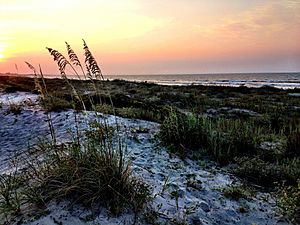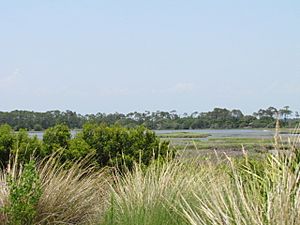Kiawah Island, South Carolina facts for kids
Quick facts for kids
Kiawah Island, South Carolina
|
|||
|---|---|---|---|

Kiawah Island sunrise
|
|||
|
|||

Location of Kiawah Island in South Carolina
|
|||
| Country | United States | ||
| State | South Carolina | ||
| County | Charleston | ||
| Incorporated as a town | 1938 | ||
| Incorporated as a city | 1957 | ||
| Area | |||
| • Total | 15.14 sq mi (39.21 km2) | ||
| • Land | 11.17 sq mi (28.93 km2) | ||
| • Water | 3.97 sq mi (10.28 km2) | ||
| Elevation | 13 ft (4 m) | ||
| Population
(2020)
|
|||
| • Total | 2,013 | ||
| • Density | 180.20/sq mi (69.58/km2) | ||
| Time zone | UTC−5 (EST) | ||
| • Summer (DST) | UTC−4 (EDT) | ||
| ZIP Code |
29455
|
||
| Area code | 843, 854 | ||
| FIPS code | 45-38162 | ||
| GNIS feature ID | 1253569 | ||
Kiawah (pronounced KEY-uh-wuh) is a beautiful sea island located on the Atlantic coast of the United States. It's a barrier island, which means it helps protect the mainland from ocean storms.
Kiawah Island is about 25 miles southwest of Charleston in Charleston County, South Carolina. It is mostly a private beach and golf resort. The island is home to the Kiawah Island Golf Resort, known for its wide beaches, large golf courses, and many other fun activities. In 2020, about 2,013 people lived on Kiawah Island. The island is part of the larger Charleston metropolitan area. You might also see the name spelled as "Kiawa," "Kittiwar," or "Kittiwah."
Contents
Island History: Exploring Kiawah's Past
The Bass Pond Site and Arnoldus Vander Horst House are important historical places on the island. They are listed on the National Register of Historic Places.
Early Days: The Kiawah Indians
Kiawah Island gets its name from the Kiawah Indians. Their leader was called a cassique. In 1670, the cassique of the Kiawah people helped English colonists find a good place to settle at Charlestowne Landing.
Island Ownership: From Pirates to Families
In 1699, a former pirate named Captain George Raynor became the owner of Kiawah Island. He later sold half of the island to Captain William Davis. The other half was passed down through his family. Eventually, John Stanyarne bought both halves of the island.
Before the Civil War, the island was mainly used for raising cattle. Over time, different parts of the island were passed down or sold to various families, including the Gibbs and Vanderhorst families.
Kiawah During Wartime: Revolutionary and Civil Wars
During the Revolutionary War, Kiawah Island was a safe place for American soldiers and their families to recover. The Vanderhorst family's home on the island was burned down during this time. However, it was rebuilt soon after the war ended.
The Civil War also affected Kiawah Island. While there are no records of major battles on the island, Northern troops took control of it. They stayed there to keep watch. Properties on the island likely suffered some damage during this period.
After the Civil War, the Vanderhorst family faced financial challenges. They managed to keep their part of the island. They hired formerly enslaved people to work the land and grow cotton. By 1870, the island was recovering, and farming was active again.
Island Development: How Kiawah Grew
For a long time, the Vanderhorst family owned Kiawah Island. In 1950, C.C. Royal bought the island to use its timber. He then started building the first summer homes there in 1954. He named the first street Eugenia after his wife.
Modern Development Begins
In 1974, Royal's family sold the island to a company from Kuwait. They carefully studied the environment and made a plan for how Kiawah would be developed. In 1976, they started selling land, and the Cougar Point golf course opened.
Growth of Golf and Resorts
The 1980s brought more golf courses to Kiawah. Turtle Point opened in 1981, and Osprey Point opened in 1988. In 1988, a group called Kiawah Resort Associates (KRA) bought the resort and undeveloped land. The Town of Kiawah was also officially created that year.
After Hurricane Hugo hit in 1989, KRA sold the resort. In the 1990s, the Kiawah Island Club was started in 1993. Three more golf courses were added: the Ocean Course (1991), the River Course (1995), and Oak Point (1997).
New Millennium: More Amenities
The last of Kiawah's main golf courses, Cassique, opened in 2000. In 2004, construction began on Freshfields Village. This area offers a mix of shops, restaurants, and services. The same year, The Sanctuary hotel also opened on the island.
In 2013, Kiawah Partners was sold to South Street Partners. This sale included the Kiawah Island Club, real estate, Freshfields Village, and other businesses.
Island Geography: Where is Kiawah?
Kiawah Island has a total area of about 15.14 square miles (39.21 square kilometers). Most of this area is land, but about 3.97 square miles (10.28 square kilometers) is water. This water includes tidal creeks and salt marshes.
Island Population: Who Lives on Kiawah?
| Historical population | |||
|---|---|---|---|
| Census | Pop. | %± | |
| 1880 | 91 | — | |
| 1990 | 718 | — | |
| 2000 | 1,163 | 62.0% | |
| 2010 | 1,626 | 39.8% | |
| 2020 | 2,013 | 23.8% | |
| U.S. Decennial Census | |||
2020 Census: A Look at the Community
| Race | Num. | Perc. |
|---|---|---|
| White (non-Hispanic) | 1,915 | 95.13% |
| Black or African American (non-Hispanic) | 20 | 0.99% |
| Asian | 22 | 1.09% |
| Other/Mixed | 25 | 1.24% |
| Hispanic or Latino | 31 | 1.54% |
As of the 2020 United States census, there were 2,013 people living in Kiawah Island. These people lived in 869 households, with 675 of them being families.
Fun on Kiawah: Parks and Recreation
Golfing Paradise: Kiawah's Courses
Kiawah Island is famous for being one of the best places to play golf on the East Coast. The island has seven amazing golf courses. Famous designers like Jack Nicklaus and Pete Dye created these courses. They wind through the island's forests and along the breezy oceanfront.
Five of the courses are part of the Kiawah Island Golf Resort. These are the Ocean Course, Turtle Point, Osprey Point, Oak Point, and Cougar Point. The other two courses, the River Course and Cassique, belong to the Kiawah Island Club.
The Ocean Course: A Challenging Design
Pete Dye designed the Ocean Course in 1991. It is known as one of the toughest golf courses on the East Coast. This course has hosted many major golf events. These include the 1991 Ryder Cup, the 1997 World Cup of Golf, and the 2012 PGA Championship. It also hosted the 2021 PGA Championship. The Ocean Course was even featured in the 2000 movie The Legend of Bagger Vance.
County Parks: Beachwalker Park
The Charleston County Park and Recreation Commission runs a park on the island called Beachwalker County Park. It is located on the west end of the island. In 2013, Forbes magazine named Beachwalker Park's beach as one of the top 10 best beaches in the United States.
Getting Around: Walking and Biking
Kiawah Island has 30 miles of paved trails. There are also 10 miles of beach. These paths are perfect for biking and walking, allowing you to enjoy the island's natural beauty.
Water Fun: Boating and Fishing
The island's tidal creeks, salt marshes, and the Kiawah River offer great chances for canoeing and kayaking. There are many places to access the water. You can rent kayaks at Mingo Point. There's also a full marina just outside Kiawah's main gate for bigger boating and deep-sea fishing trips.
Education: Schools on the Island
Kiawah Island is part of the Charleston County School District. Students living on the island typically attend Mount Zion Elementary School, Haut Gap Middle School, and St. John's High School.
Famous Residents: People Who Live on Kiawah
Many well-known people own homes on Kiawah Island. Some of them include:
- Ray Allen, a famous NBA basketball player.
- Joe Gibbs, a retired Hall of Fame NFL head coach and racing team owner.
- Nikki Haley, who was the Governor of South Carolina and a United States Ambassador.
- Jeffrey Immelt, a former CEO of General Electric.
- Tara Lipinski, an Olympic gold-medalist figure skater.
- Dan Marino, a retired NFL quarterback.
- George Will, a well-known columnist.
- Ty Cobb, a former White House lawyer.
Images for kids
See also
 In Spanish: Kiawah Island para niños
In Spanish: Kiawah Island para niños








